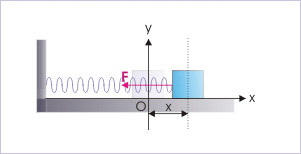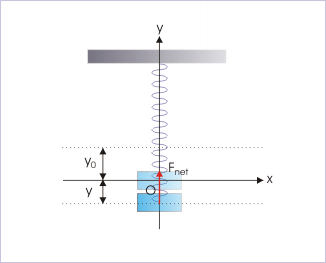| << Chapter < Page | Chapter >> Page > |
Block – spring system presents an approximation of SHM. It is assumed that spring force follows Hooke’s law and there is no dissipating forces like friction or air drag. The arrangement consisting of spring with block attached at one end has many interesting variations. We analyze all such arrangements following certain basic steps to arrive at formulations for periodic attributes like time period and frequency etc.
The first step is to drive an equation between force and displacement or between acceleration and displacement. We, then, use standard expression to determine time period and frequency. Broadly, we shall be working to analyze following variations consisting of a block and spring(s) :
The Hooke’s law governing an ideal spring relates spring force with displacement as :
Horizontal block-spring system

Combining with Newton’s second law,
Now, comparing with SHM relation “ ”, we have :
In these expressions “m” and “k” represent inertia and spring factor respectively.
Vertical block-spring system differs to horizontal arrangement in the application of gravitational force. In horizontal orientation, gravitational force is perpendicular to motion and as such it is not considered for the analysis. In vertical orientation, however, the spring is in extended position due to the weight of the block before the block is set in SHM. It is in equilibrium in the extended position under the action of gravitational and spring force.
Clearly, the center of oscillation is the position of equilibrium. The block oscillates about the extended position – not about the position of neutral spring length as in the case of horizontal arrangement. Let us consider that the spring is extended by a vertical length “ ” from neutral position when it is in equilibrium position. For a further extension “y” in spring, the spring force on the block is equal to the product of spring constant and total displacement from the neutral position,
Vertical block-spring system

Note that we have considered downward displacement as positive. The spring force acting upward is opposite to displacement and hence negative. In this case, however, the net restoring force on the block is equal to the resultant of spring force acting upwards and gravity acting downward. Considering downward direction as positive,
But, for equilibrium position, we have the following relation,
Substituting this relation in the expression of net restoring force, we have :
The important point to realize here is that net restoring force is independent of gravity. It is equal to differential spring force for the additional extension – not the spring force for the total extension from the neutral position. Now, according to Newton’s second law of motion, the net restoring force is equal to the product of mass of the block and acceleration,

Notification Switch
Would you like to follow the 'Oscillation and wave motion' conversation and receive update notifications?